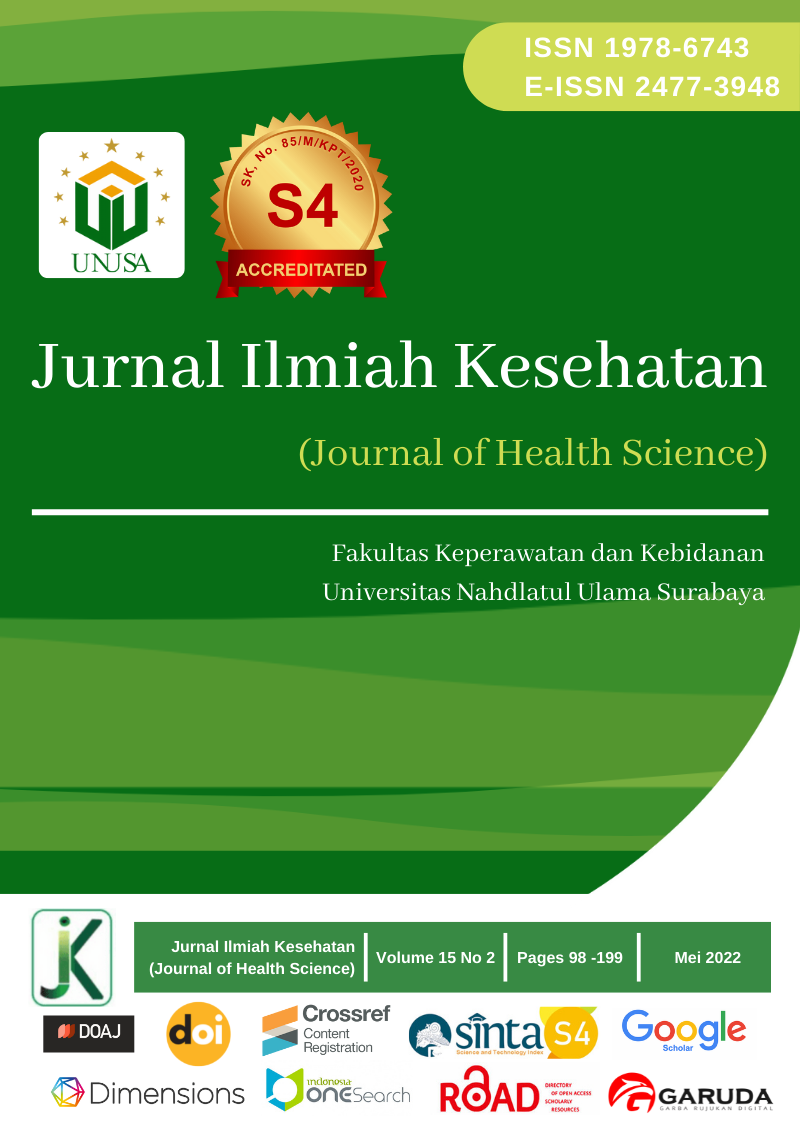The Correlation Between Feeding Patterns And The Incidence Of Stunting In Children Aged 0-59 Months
Main Article Content
Abstract
Stunting is one of the severe problems in Indonesia. One of its causes is a lack of nutritional intake during infancy. In addition, maternal parenting, especially in feeding patterns, will affect the children's growth and development. This study aims to determine the correlation between feeding patterns and the incidence of stunting. The research design used correlational analytics. The population was stunted children aged 0-59 months at Kalibuntu Village, Probolinggo Regency. In addition, there were 66 respondents in this study with total sampling. The independent variable was feeding patterns, while the dependent variable was the incidence of stunting. Data collection was carried out using a questionnaire on feeding patterns that respondents' mothers filled out. In addition, the authors measured respondents' height and assessed with a WHO (World Health Organization) growth chart to collect data on the incidence of stunting. Data analysis used the Spearman rank rho test. Almost half of the respondents had inappropriate feeding patterns (42.4%). In addition, most of the stunted children's height was categorized as short (85.3%). 15.2% of stunted children with inappropriate feeding patterns had very short height. In addition, 56.1% of respondents with appropriate feeding patterns were categorized as short. The Spearman rank rho test obtained p=0.000, indicating H0 was rejected and H1 was accepted. In addition, the value of the correlation coefficient was 0.439, showing a moderate correlation between both variables. In conclusion, feeding patterns correlate with the incidence of stunting among children aged 0-59 months in Kalibuntu Village, Probolinggo Regency.
Downloads
Article Details
Copyright (c) 2022 tutik hidayati, Rizki Citra Dewi Pratiwi

This work is licensed under a Creative Commons Attribution-ShareAlike 4.0 International License.
References
Apriani, V. (2019) Penyebab, Ciri-Ciri Dan Dampak Stunting. Available at: https://www.siswapedia.com/penyebab-ciri-ciri-dan-dampak-stunting/.
Bella, F.D., Fajar, N.A. and Misnaniarti, M. (2020) ‘Hubungan pola asuh dengan kejadian stunting balita dari keluarga miskin di Kota Palembang’, Jurnal Gizi Indonesia, 8(1), p. 31. doi:10.14710/jgi.8.1.31-39.
Dasman, H. (2019) ‘Empat dampak stunting bagi anak dan negara Indonesia’, The Conversation (Disipln Ilmiah, gaya Jurnalistik), pp. 2–4. Available at: http://repo.unand.ac.id/21312/1/Empat dampak stunting bagi anak dan negara Indonesia.pdf.
Kementerian Kesehatan RI (2020) STANDAR ANTROPOMETRI ANAK. Indonesia.
Purwani, Erni and Mariyam (2013) ‘Pola Pemberian Makan Dengan Status Gizi Anak Usia 1 Sampai 5 Tahun Di Kabunan Taman Pemalang’, Jurnal Keperawatan Anak, 1(1), pp. 30–36. Available at: http://download.portalgaruda.org/article.php?article=98477&val=5091.
Rahayu, A. et al. (2018) ‘Surat Pencatatan Ciptaan: Gizi 1000 Hari Pertama Kehidupan’.
Ridha Cahya Prakhasita (2019) Hubungan Pola Pemberian Makan Dengan Kejadian Stunting Pada Balita Usia 12-59 Bulan Di Wilayah Kerja Puskesmas Tambak Wedi Surabaya. Universitas Airlangga.
Waryono (2010) Pemberian Makanan, Suplemen dan Obat pada Anak. Jakarta: EGC.
Yuliana, W. et al. (2019) Darurat stunting dengan melibatkan keluarga. Yayasan Ahmar Cendekia Indonesia.





